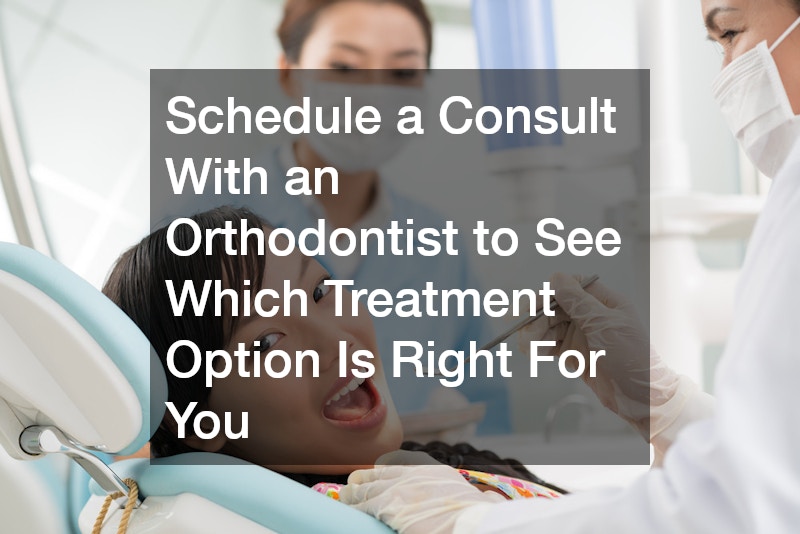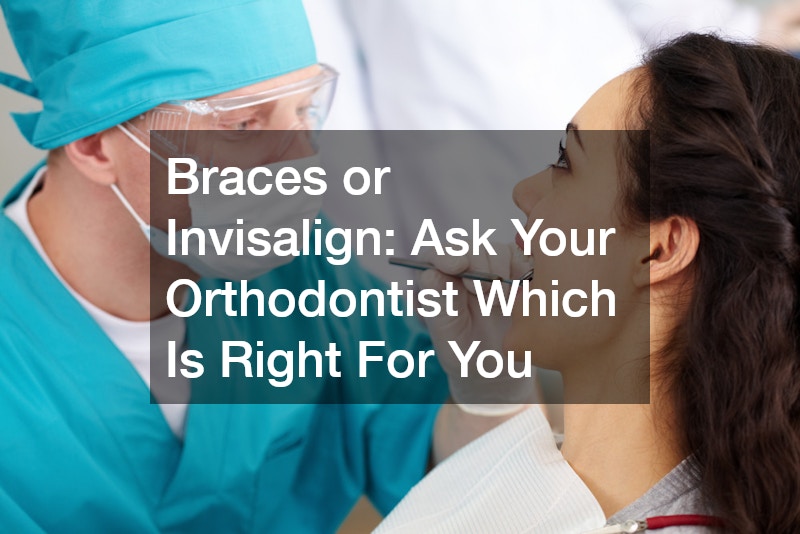This article aims to help you understand the differences between braces and Invisalign, and how to decide which option is best for you with the guidance of an orthodontist.
What are the Main Differences Between Braces and Invisalign?
A. Appearance and Aesthetics
When considering orthodontic options, aesthetics often play a significant role in decision-making. Traditional braces, typically made from metal, are easily noticeable and can affect a person’s confidence when smiling.
On the other hand, Invisalign aligners are clear and more discreet, making them a preferred choice for those concerned about the appearance during treatment.
Braces come in various materials, such as ceramic and lingual, which offer more aesthetically pleasing alternatives, albeit at a higher cost. Invisalign, being almost invisible, is conducive for individuals prioritizing appearance, particularly adults and teens. However, both options are designed to effectively align teeth despite their differing appearances.
Choosing between braces and Invisalign can depend heavily on the social or professional scenarios one frequently encounters. For those in public-facing roles, Invisalign might seem more appealing due to its subtlety. Regardless of choice, both methods have evolved over the years to become less intrusive aesthetically.
B. Comfort and Pain Levels
Comfort is another primary concern when selecting an orthodontic treatment. Traditional braces can cause discomfort due to metal brackets and wires, which can irritate the inner surfaces of the mouth. Conversely, Invisalign aligners are made of smooth plastic, which generally offers a more comfortable experience.
Braces require periodic adjustments that can result in temporary discomfort or soreness for the wearer. On the upside, this method is known for applying consistent pressure to move teeth efficiently. Invisalign offers the advantage of being removable, allowing users to manage occasional discomfort by removing aligners temporarily if necessary.
While both options eventually lead to better dental alignment, individual tolerance for pain and comfort must be considered. Consulting with an orthodontist can offer insights into what levels of discomfort to expect from each method. Ultimately, patient perception of pain can vary significantly, necessitating personalized discussions about comfort.
How Effective are Braces Compared to Invisalign?
A. Complexity of Dental Issues
The effectiveness of orthodontic treatment largely depends on the specific dental issues needing correction. Braces are highly versatile and can address a more comprehensive range of dental problems, such as severe misalignments and bites. In contrast, Invisalign is best suited for mild to moderate orthodontic cases.
Complex cases often require the robust force that braces provide, allowing them to make significant modifications to tooth positioning. Invisalign has limitations due to its design, making it less effective for complex malocclusions or those needing precise tooth manipulation. Therefore, an orthodontist’s evaluation of complexity will significantly influence the choice between braces and Invisalign.
Modern advancements in orthodontics have improved Invisalign’s range, yet some scenarios still require traditional braces. Orthodontists may even opt for a combination approach, employing both braces and Invisalign at different stages of treatment to maximize effectiveness. A professional consultation can clarify which approach best fits a patient’s particular dental needs.
B. Duration of Treatment
Another factor to consider is the expected duration of treatment for each option. Braces typically require continuous wear for approximately 18 to 24 months, depending on the complexity of the case. Invisalign users, however, might complete their alignment process within 12 to 18 months if they closely adhere to the prescribed wear schedule.
The treatment timeline can be influenced by individual compliance and the severity of the issues addressed. Braces generally guarantee consistent pressure and progression due to their fixed nature, often translating into predictable treatment timelines. Invisalign demands diligent adherence to recommended wear times of 20 to 22 hours per day to remain on schedule.
Delays in treatment can occur if patients do not follow through with prescribed guidelines or miss regular appointments. Regardless of the chosen method, staying committed to the treatment plan is crucial for achieving timely results. Ultimately, patients should discuss their timeline expectations with their orthodontist to plan accordingly.
C. Long-term Results and Retainers
Both braces and Invisalign aim to achieve long-term dental alignment, whose effects depend on post-treatment care. The use of retainers after braces is essential to maintain alignment, usually requiring indefinite nighttime wear. Invisalign treatments include the last aligner or a specific retainer to maintain newly aligned positions.
Retention is vital in avoiding regression, where teeth attempt to return to their pre-treatment state. Patients must understand that lifelong retention is crucial regardless of how initially effective the treatment is. Although the treatment methods differ, the necessity of retainers remains constant across both options.
The choice between braces and Invisalign should factor in not only immediate results but also long-term outcomes. Consistent follow-up visits with an orthodontist can help ensure long-term effectiveness. Successful maintenance leads to sustained smile enhancement and contributes greatly to patient satisfaction.
Which Option is More Convenient for Daily Life?
A. Eating Restrictions
Daily lifestyle implications often influence the choice between braces and Invisalign. Braces necessitate dietary adjustments to avoid damaging the brackets and wires. Foods like nuts, hard candies, and certain sticky items are usually prohibited during treatment.
Invisalign, being removable, allows patients to enjoy a more unrestricted diet. Individuals can maintain their usual eating habits by simply removing aligners at mealtimes, making Invisalign more convenient for food enthusiasts. The catch, however, lies in diligently brushing before wearing aligners again to prevent potential tooth damage.
This flexibility underscores Invisalign’s appeal among candidates who prioritize minimal dietary disruptions. For those less inclined to manage dietary constraints meticulously, traditional braces may prove challenging. Open discussions with an orthodontist can help ensure the chosen method fits well into one’s overall dietary lifestyle.
B. Oral Hygiene and Maintenance
Maintaining oral hygiene is imperative for both braces and Invisalign users. Braces require meticulous brushing and flossing between brackets to prevent plaque buildup and decay. Various specialized tools, such as interdental brushes, are available to aid with effective cleaning around braces components.
Conversely, Invisalign promotes easier oral hygiene, as aligners can be removed to permit uninhibited brushing and flossing. This facilitates retaining a thorough hygiene routine without needing specialized tools. However, it remains crucial to clean both teeth and the aligners consistently to avoid bacterial growth and aligner staining.
The impact of oral hygiene on overall dental health suggests a strong reason for selecting Invisalign for individuals keen on straightforward maintenance. Improved hygiene practices contribute to better outcomes and enhance the overall orthodontic experience. It is essential to discuss maintenance preferences and abilities with an orthodontist when deciding.
How Do I Choose the Right Option for Me?
A. Consultation with an Orthodontist
The pivotal step in selecting the right treatment option involves a detailed consultation with a qualified orthodontist. Specialists provide valuable insights into both methods, tailoring recommendations according to individual cases. Comprehensive assessments cover dental health, treatment suitability, and patient-specific factors.
Conducting diagnostic tests further supports informed treatment decisions tailored to patient needs. Orthodontists have the expertise to identify specific treatment plans aligning with desired outcomes and case complexities. Professional consultations anchor decisions in evidence-based practices, serving patient interests and promoting successful outcomes.
Rest assured that consultations with orthodontic teams prioritize patient goals and health. Personal preferences seamlessly blend with clinical assessments to streamline decision-making processes. In valuing professional expertise, patients move forward with confidence in achieving their ideal dental alignment.
B. Personal Needs and Preferences
When deciding between braces and Invisalign, individual lifestyles and preferences play an integral role. Evaluating daily routines, dietary habits, aesthetic concerns, and personal priorities empowers patients to declare informed choices. The integration of personal desires with treatment logistics paves the path for tailored solutions.
By introspectively reflecting on lifestyle dynamics and personal adaptability, individuals can align treatment choices with comfort and convenience. Exercising self-awareness fosters successful adherence to treatment care plans, thus avoiding unnecessary disruptions. Consulting orthodontic professionals ensures their expertise harmonizes with personal inclinations.
Understanding personal thresholds for managing discomfort, dietary changes, and adaptation leads to informed choices. The personalization process transforms orthodontic experiences into meaningful, purposeful journeys. Encapsulating personal satisfaction into decisions fortifies commitment and satisfaction in achieving optimal dental health.
Understanding and evaluating both braces and Invisalign requires a multifaceted approach grounded in professional guidance. By examining key factors such as aesthetics, comfort, cost, and effectiveness, patients can navigate their orthodontic journey confidently. Engaging in open, consultative dialogues with specialists allows tailored decisions, ultimately aligning treatment choices with personal lifestyle and health goals.

